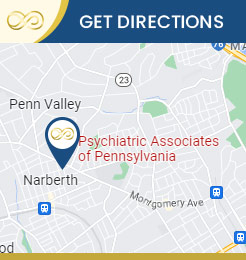Autism Spectrum Disorder Experts in Narberth PA, on the Main Line of Philadelphia
Do you ever wonder: What is Autism Spectrum Disorder, or ASD? Is Autism different than Asperger’s? How do I know if my loved one or I have autism? What are the main symptoms of autism and how is it diagnosed? How is autism treated and managed? Our autism spectrum disorder specialists are here to help. For more information, contact us or schedule an appointment online. We are conveniently located on the Main Line of Philadelphia, serving patients from Narberth PA, Philadelphia PA, Media PA, King of Prussia PA, Newtown Square PA, Wayne PA, Malvern PA, Abington PA, Plymouth Meeting PA, Ardmore PA, Villanova PA, and surrounding areas.


Table of Contents:
What is Autism Spectrum Disorder?
What are symptoms of Autism Spectrum Disorders?
What causes Autism Spectrum Disorder?
How is Autism Spectrum Disorder treated?
What is the difference between Autism Spectrum Disorders and Asperger’s Disorder?
Autism Spectrum Disorder (ASD) is a neurodevelopmental disorder that affects communication, social interaction, and behavior. It is characterized by a range or “spectrum” of symptoms that can vary widely in severity and presentation. Individuals with ASD may have difficulties with social interactions, communication (both verbal and non-verbal), repetitive behaviors, and sensory sensitivities.
Autism Spectrum Disorder (ASD) encompasses a wide range of symptoms that can manifest differently in each individual. The symptoms typically appear in early childhood and persist throughout a person’s life. Here are some common symptoms and characteristics associated with ASD:
– Social Communication Challenges
o Difficulty with reciprocal conversation and back-and-forth communication.
o Limited use of gestures, facial expressions, and body language.
o Difficulty understanding and responding to social cues and norms.
o Literal interpretation of language and difficulty understanding sarcasm or figurative speech.
– Impaired Social Interactions
o Difficulty establishing and maintaining relationships.
o Lack of interest in sharing experiences or emotions with others.
o Limited empathy or understanding of others’ perspectives.
o Difficulty making and maintaining friendships.
– Restricted and Repetitive Behaviors
o Engaging in repetitive movements such as hand flapping, rocking, or spinning.
o Strict adherence to routines and rituals, becoming upset by changes.
o Highly focused or intense interests in specific topics or objects.
o Unusual or exaggerated sensory responses, such as aversion or seeking certain textures, sounds, or lights.
– Communication Difficulties
o Delayed language development or speech impairments.
o Difficulty initiating and sustaining conversations.
o Echolalia (repeating words or phrases).
o Literal interpretation of language, difficulty understanding metaphors or sarcasm.
– Sensory Sensitivities
o Hypersensitivity or hyposensitivity to sensory input (e.g., sound, touch, taste, smell).
o Overwhelmed or distressed by certain textures, loud noises, or bright lights.
o Unusual interests in sensory aspects (e.g., repeatedly smelling objects).
It’s important to note that while these are common symptoms, not all individuals with ASD will exhibit every symptom, and the severity can vary widely. A formal diagnosis from a qualified healthcare professional is necessary to determine if someone has ASD.
The exact causes of Autism Spectrum Disorder (ASD) are still not fully understood. However, research suggests that a combination of genetic and environmental factors likely contribute to the development of ASD. Here are some key factors that have been identified:
Genetic Factors: Studies have shown that there is a strong genetic component to ASD. Certain gene mutations or variations can increase the risk of developing ASD. However, it’s important to note that no single gene has been identified as the sole cause of ASD. Rather, it is believed that a complex interplay of multiple genes is involved, and different combinations of genetic factors may contribute to the development of ASD in different individuals.
Environmental Factors: Environmental influences during early development, both before and after birth, may also play a role in the development of ASD. Factors such as prenatal exposure to certain medications, maternal infections during pregnancy, complications at birth, and exposure to air pollutants have been studied as potential environmental risk factors. However, more research is needed to fully understand the specific environmental factors and their interactions with genetic factors.
Brain Development and Connectivity: It is widely believed that ASD involves atypical brain development and connectivity. Early brain overgrowth or abnormal wiring of neural connections during critical periods of development may impact the way individuals with ASD perceive and process information. However, the specific mechanisms and underlying brain differences associated with ASD are still being investigated.
It’s important to note that ASD is not caused by parenting practices or social factors. Extensive research has debunked the notion that ASD is caused by emotional neglect, vaccines, or other external factors that have been falsely implicated in the past. It’s worth mentioning that ASD is a complex disorder, and each individual’s experience is unique. Ongoing research aims to unravel the complexities of ASD and gain a better understanding of its causes and potential interventions.
The treatment of Autism Spectrum Disorder (ASD) typically involves a multi-faceted approach that addresses various aspects of an individual’s development and functioning. The goal of treatment is to support individuals with ASD in maximizing their potential, enhancing their quality of life, and improving their social interactions, communication skills, and adaptive behaviors. Here are some commonly used interventions and therapies:
Behavioral and Educational Interventions: Applied Behavior Analysis (ABA) is a widely used behavioral therapy that focuses on shaping and reinforcing desired behaviors while reducing challenging behaviors. It involves breaking down skills into manageable steps and providing positive reinforcement. Other educational interventions, such as structured teaching approaches like the Picture Exchange Communication System (PECS) or the use of visual schedules, may be employed to support learning and communication.
Speech and Language Therapy: Many individuals with ASD experience challenges with communication and language skills. Speech and language therapy can help improve communication abilities, including expressive language, receptive language, articulation, and pragmatic skills (social use of language). Therapy sessions may involve structured activities, social interaction practice, and augmentative and alternative communication (AAC) strategies when needed.
Occupational Therapy: Occupational therapy aims to help individuals develop skills necessary for daily living, self-care, and fine motor coordination. It may involve activities that address sensory sensitivities, enhance motor skills, promote independence, and improve sensory integration.
Social Skills Training: Social skills training focuses on teaching individuals with ASD appropriate social behaviors, including non-verbal cues, turn-taking, initiating and maintaining conversations, and understanding social norms. Group therapy settings may be used to practice social interactions in a structured and supportive environment.
Medication: Medication is not a treatment for the core symptoms of ASD but may be prescribed to manage co-occurring conditions such as anxiety, depression, hyperactivity, or aggression. Medication is typically used in conjunction with other therapies and is tailored to an individual’s specific needs.
Parental and Family Support: Providing support and education to parents and family members is crucial. Parent training programs can help caregivers learn strategies to manage challenging behaviors, improve communication, and promote positive interactions with their child. Support groups and counseling services are also available to assist families in coping with the challenges associated with ASD.
Neurofeedback: Although evidence is still limited, and its effectiveness as a standalone treatment for ASD is not yet firmly established, some individuals with ASD may find it beneficial as part of a comprehensive treatment plan. The aim of neurofeedback is to help individuals with ASD develop better self-regulation of their brain activity, potentially leading to improvements in cognitive functioning, attention, emotional regulation, and behavior control. By learning to regulate their brainwaves, individuals may develop greater focus, reduced impulsivity, and improved executive functioning skills.
It’s important to note that interventions should be individualized and tailored to the unique strengths, needs, and preferences of each person with ASD. Early intervention is particularly beneficial, so it’s recommended to start appropriate therapies as soon as ASD is diagnosed. Ongoing evaluation, adjustment of interventions, and collaboration between professionals, caregivers, and educators are essential components of effective treatment for ASD.
Autism and Asperger’s Syndrome were previously considered separate diagnostic categories within the autism spectrum. However, with the publication of the Diagnostic and Statistical Manual of Mental Disorders, Fifth Edition (DSM-5) in 2013, the distinction between autism and Asperger’s Syndrome was removed, and they are now both considered part of Autism Spectrum Disorder (ASD). This change was made to recognize the similarities between autism and Asperger’s and to promote a more unified understanding and approach to diagnosis and treatment.
Previously, Asperger’s Syndrome was characterized by having no significant delay in language development, average or above-average intelligence, and a particular interest or preoccupation with specific subjects or topics. However, individuals with Asperger’s still exhibited challenges with social interaction, communication, and repetitive behaviors—similar to those with autism.
Under the current diagnostic criteria of ASD, the focus is on identifying the presence and severity of symptoms related to social communication challenges, restricted and repetitive behaviors, and sensory sensitivities. The severity of these symptoms can range from mild to severe, resulting in a diverse spectrum of presentations and support needs.
It’s important to note that while the term “Asperger’s Syndrome” is no longer officially used as a separate diagnosis, many individuals and communities still identify with the term and find it meaningful to describe their experiences. The shift to using the umbrella term ASD is aimed at emphasizing the shared characteristics and challenges faced by individuals across the spectrum, promoting a more inclusive understanding of the condition.


Additional Conditions We Treat
▸ Life Transitions
▸ Depression & Other Mood Disorders
▸ Anxiety Disorders
▸ PTSD & Other Trauma Related Disorders
▸ Obsessive Compulsive Disorders
▸ Attention Deficit and Hyperactivity Disorder (ADHD)
▸ Bipolar Disorders
▸ Eating Disorders
▸ Autism Spectrum Disorders
▸ Psychotic Disorders
▸ Sleep Disorders
▸ Phobia Experts
▸ Gender Dysphoria
▸ LGBTQIA+ Affirmative Therapy
▸ Men’s Mental Health
▸ Women’s Issues
▸ End of Life Mental Health
Additional Services You May Need
▸ Psychiatry and Medication Management
▸ Child and Adolescent Psychiatry
▸ Therapy and Counseling
▸ Treatment Resistant Depression
▸ Treatment Resistant OCD
▸ Smoking Cessation
▸ Transcranial Magnetic Stimulation (TMS)
▸ Psychoeducational Assessments
▸ Eating Disorders Program
▸ Neurofeedback
▸ Neurotechnology
▸ Virtual Reality Exposure Therapy
▸ Genetic Counseling
▸ Preventative Mental Health
▸ Forensic Psychiatry
▸ Anger Management
▸ Cognitive Behavioral Therapy
▸ Couples Counseling
▸ EMDR
▸ Family Therapists
▸ Grief Counselors
▸ Mindfulness and Meditation
▸ Palliative Psychology
▸ Internal Family Systems
▸ Parenting Coach
▸ Executive Mental Health


